Abstract
The peak dilation angle is an important mechanical feature of rock discontinuities, which is significant in assessing the mechanical behaviour of rock masses. Previous studies have shown that the efficiency and accuracy of traditional experimental methods and analytical models in determining the shear dilation angle are not completely satisfactory. Machine learning methods are popular due to their efficient prediction of outcomes for multiple influencing factors. In this paper, a novel hybrid machine learning model is proposed for predicting the peak dilation angle. The model incorporates support vector regression (SVR) techniques as the primary prediction tools, augmented with the grid search optimization algorithm to enhance prediction performance and optimize hyperparameters. The proposed model was employed on eighty-nine datasets with six input variables encompassing morphology and mechanical property parameters. Comparative analysis is conducted between the proposed model, the original SVR model, and existing analytical models. The results show that the proposed model surpasses both the original SVR model and analytical models, with a coefficient of determination (R2) of 0.917 and a mean absolute percentage error (MAPE) of 4.5%. Additionally, the study also reveals that normal stress is the most influential mechanical property parameter affecting the peak dilation angle. Consequently, the proposed model was shown to be effective in predicting the peak dilation angle of rock discontinuities.
1. Introduction
The forecasting and control of the mechanical behaviour of rock masses is an important factor regarding the safety of engineering structures [1,2,3,4,5]. The design of structures such as tunnels, embankments, mine openings, and underground chambers relies on accurate and reliable estimates of compressive strength, tensile strength, hydraulic mechanics, internal damage characteristics, and shear strength of rock masses [6,7,8,9,10,11]. It is generally accepted that rock masses are often cut into intact rock pieces by rock discontinuities at different scales, as shown in Figure 1. These rock discontinuities include fractures, joints, bedding planes, weak intercalations, shear planes, etc. [12,13]. Due to the shear strength of rock discontinuities closely related to rock engineering disasters, such as rock slope failure, fault-slip burst, and collapse accidents in tunnels [14,15,16], it has attracted the attention of researchers [17,18,19,20,21].
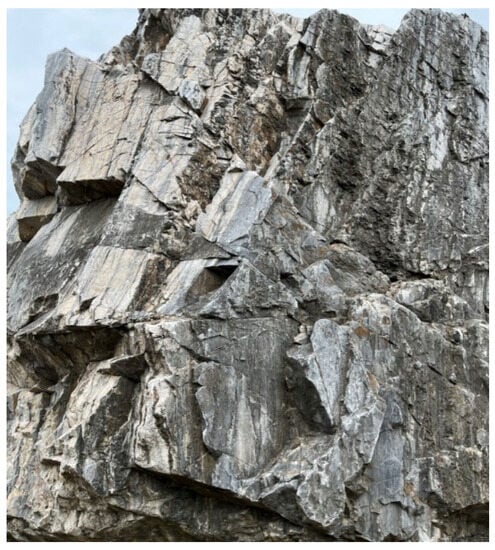
Figure 1.
Photograph of rock outcrops in China.
The Mohr–Coulomb law is widely used to characterise shear behaviours of rock discontinuities in the existing shear strength models, which incorporates the internal friction angle comprising the basic friction angle and the peak dilation angle [22,23]. At the same time, there is an excellent modern-day geotechnical software, FLAC3D5.0, in which this law is taken as a basis and allows for predicting the behaviour of rock masses in different conditions [24,25]. The peak dilation angle reflects the comprehensive effect of the joint morphology on the shear strength [26,27]. Generally speaking, the peak dilation angle is defined as the instantaneous inclination of the shear path at the shear strength with respect to the mean plane [28]. In addition, the peak dilation angle is also the most commonly used parameter in numerical calculations to study the nonlinear shear dilation behaviour of rock materials and to simulate surrounding rock deformation [29,30,31,32,33].
The dilation is also inherent to failure in specimens starting from intact material, and it is a fundamental parameter for models with softening or hardening behaviour, also modified by the average stress level acting along the stress path. Currently, numerous experimental studies [34,35] on the peak dilation angle have been carried out. Moreover, theoretical analysis and many empirical models [36,37] were established based on the concept of maximum dilation angle at zero normal stress. These models have some shortcomings. For example, Xia et al. [38] proposed a new empirical model by tensile joint replicas satisfying new peak dilation angle boundary conditions under zero and critical state normal stresses. However, as the normal stress increases, the peak dilation angle predicted by the Xia et al. [38] model is half of the initial dilatation angle, which is inconsistent with the actual behaviour [39]. For this, Yang et al. [39] established a new empirical model based on the shear test results of granite joints and sandstone joints. Ban et al. [40] also took into account the real contact asperity distribution and proposed a semi-empirical model. Additionally, there are many empirical models for predicting the peak dilation angle and shear strength of rock discontinuities, as listed in Table 1. These models provide a valuable basis for understanding and predicting the peak dilation angle. However, the generality of these models has not been well-addressed and some model parameters lack clear physical meaning. From an engineering practicality point of view, an ideal model should be able to accurately assess the peak dilation angle in a time-saving, labour-saving, and cost-effective way.

Table 1.
An overview of existing shear strength models.
Rock materials exhibit complex behaviours and a high level of uncertainty under laboratory testing [49,50,51,52,53,54]. Machine learning (ML) techniques have been developed and used by an increasing number of researchers in the last several decades [55,56,57,58,59,60,61,62]. Compared with traditional test methods and empirical models, ML can effectively find implicit relationships between variables and well handle nonlinear problems [63,64]. The support vector regression (SVR) algorithm presents high accuracy and efficiency in modelling the nonlinear association between input variables and outputs, and it has been widely used in rock mechanics modelling in recent years [65]. For example, Huang et al. [66] used the joint roughness coefficient (JRC), uniaxial compressive strength, normal stress, and basic friction angle as the input variables of the SVR model to intelligently predict the shear strength. Under the framework of SVR, Babanouri and Fattahi [67] proposed a new shear constitutive model of rock discontinuity. Ceryan et al. [68] developed an SVR model to predict the elastic modulus of rock materials with different degrees of weathering. Recently, Xu et al. [69] used SVR to study multiple geomechanical properties of rock materials. In conclusion, SVR exhibits several distinct advantages when tackling challenges involving high-dimensional and nonlinear recognition problems.
It can be noted that the peak dilation angle model of rock discontinuities is a very topical issue. Therefore, the purpose of this study is to provide an efficient method for predicting the peak dilation angle of rock discontinuities and to achieve this. The grid search optimization algorithm (GS) is introduced to improve the effect of the SVR, and a hybrid machine learning model, the GS-SVR model, is proposed. In addition, to show the development process of the proposed model, detailed analysis and model performance are also presented. Finally, the limitations and future development progress of the proposed model are outlined.
2. Methodological Background
2.1. SVR
As a typical kernel-based ML algorithm, SVR is a promotion of support vector machine (SVM). It also follows the function approximation algorithm of SVM and solves the multivariate nonlinear regression estimation problem by introducing an alternative loss function [70]. As a supervised learning method based on the principle of structural risk minimization, SVR has good generalization ability in solving small-sample, nonlinear, and high-dimensional problems [71]. Because it is a convex quadratic optimization technique, it can always achieve the global optimal solution [72]. Figure 2 displays a schematic diagram of the SVR employed in this paper. SVR uses nonlinear mapping to translate the input vector X into a space with higher dimensions. More details about SVR and its application can be found in other milestone papers [73,74,75]. In this work, SVR is chosen as the regression tool to predict the peak dilation angle because of its high generalization performance. It is worth mentioning that the relationship between peak dilation angle and underlying variables is nonlinear, high-dimensional, and the training data are generally not large. That circumstance is particularly suitable for SVR.

Figure 2.
Schematic diagram of the SVR.
For a certain set of training data {(x1, y1), (x2, y2), …(xn, yn)}, the aim is to seek an optimal function f(x) that has at most ε deviation from the target values ytar for all the training data. The optimal function f(x) that has the most ε deviation from the target value in ε-SVR can be written as Equation (1):
where ω is the weight vector, b is the model error, N represents the total number of training data, φn(x) denotes a nonlinear mapping function.
Subsequently, the overall optimization is optimally transformed into Equation (2).
where the Euclidean norm is .
The constraints of Equation (2) are shown below:
By introducing two slack variables ξi and ξi∗ (i = 1, 2…, n) into Equation (3) representing the separation between the actual values and corresponding boundary values of ε-deviation. Further, the w and b can be determined by minimizing the following optimization function
where c is the regularization or penalty parameter that is greater than zero.
The term denotes the structure risk and the second term represents the empirical risk. Equation (4) is a constrained optimization problem that can be transformed in the form of a Lagrange function L(α, α*) by sequential minimal optimization algorithm in a dual form:
where αi and αi* are the Lagrangian multipliers, K(xi,xj) = φ(xi)φ(xj) is the kernel function that yields the inner product in a higher-dimensional feature space.
By using K(xi,xj), one can directly transform the data into a higher-dimensional feature without calculating the explicit map φ(x). In this paper, the radial basis function kernel function (RBF) is employed because of its high generalization performance.
where g denotes the kernel parameter, is the Euclidean distance.
The nonlinear regression function can be expressed as follows after taking the Lagrangian and optimum conditions into account:
2.2. GS Optimization
In order to achieve accurate prediction, an important issue to be concerned with in implementing the SVR model is the tuning of hyperparameters (e.g., penalty parameter c and width parameter g). The trade-off between model complexity and training error is controlled by c, while the complexity of the solution is determined by g. The tuning process is generally completed through optimization algorithms.
As a classical parameter optimization method, the grid search (GS) method is proved to be an efficient optimization method with ideal convergence speed and success rate [76]. It is a method of optimizing the performance of a model by traversing a given combination of parameters, by testing all combinations of a given parameter and finding the most suitable combination. The specific optimization process is shown in Figure 3. The evaluation metrics, such as root mean square error (RMSE), coefficient of determination (R2), and mean squared error (MSE), are obtained using K-fold cross-validation for all hyperparameter combinations of the selected grid nodes. The best combination of c and g, which resulted in the best performance of the evaluation metrics, was selected for subsequent model validation.
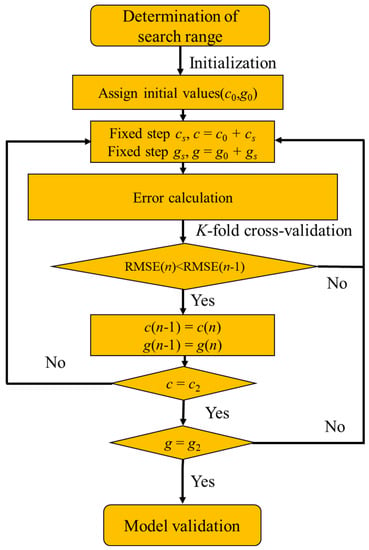
Figure 3.
Computation flowchart of grid search method.
3. Data Pre-Processing
A dataset with reliable experimental results and wide distribution is a prerequisite for the successful application of ML modelling [77,78]. Based on the literature review of the existing research method [39,40], six parameters, including normal stress, basic friction angle, three-dimensional roughness parameters, and uniaxial compressive strength, were selected as the input variables of the proposed model.
The results of joint shear tests available in the literature are compiled. The dataset consists of 89 shear test results from various experimental results collected by the authors. These test results cover common joint types, such as cement mortar [40], granite [39,79], sandstone [38,39,80], marble [79], and limestone [79], and the projected lengths of these rock discontinuities ranged from 140 to 300 mm. More information on sample preparation procedures can be found in the corresponding literature. Detailed information on rock type, sample size, normal stress (σn), mechanical properties (uniaxial compressive strength σc and basic friction angle φb), three-dimensional roughness parameters (A0, C, θmax*), and measured peak dilation angle (ip) collected in the dataset are shown in the Supplemental Files. A detailed statistical description of the input variables and output variable is shown in Table 2. As shown, there is an evident difference in the data distribution (e.g., data scope, magnitude difference) for variables. Therefore, in order to speed up the computational efficiency and convergence of ML, all inputs and output need to be normalized to (0,1) range according to their maximum and minimum values. The normalization formula is shown in Equation (8) as follows:
where xi’ and yi’ represent normalized input and output values of the i-th sample; xi and yi represent experimental input and output values of the i-th sample; xmin, xmax, ymin, ymax represent corresponding minimum and maximum values.

Table 2.
Statistical description of inputs and output.
The distribution characteristics of the dataset are visualized by means of a violin plot, as shown in Figure 4. It combines the features of a kernel density plot and a box plot while showing the first quartile, median, and third quartile of the dataset. A matrix analysis was plotted to show the correlation coefficients between the variables, with negative numbers representing negative correlations. It is easy to see from Figure 5 that all the correlation coefficients are less than 0.53, which indicates that these input variables are independent of each other and do not cause multicollinearity problems. Moreover, the correlation coefficients between the input and output variables are relatively low (all values are less than 0.35 in absolute value), which indicates that the relationship between the peak dilation angle and these inputs is not a simple multivariate linear relationship but a complex nonlinear mapping relationship. In other words, it is difficult to establish an explicit equation between the peak dilation angle and the inputs. This is the reason why machine learning methods are used to predict the peak dilation angle in this paper.
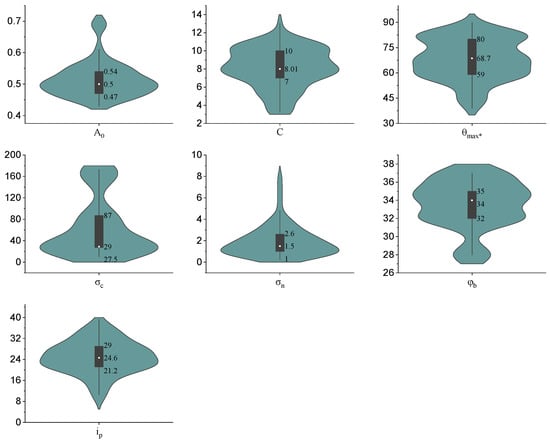
Figure 4.
Violin plots of variables used in the database.
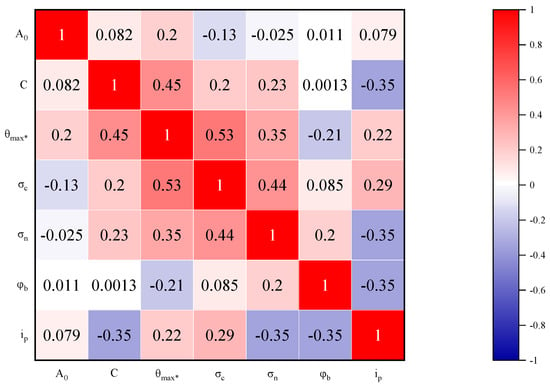
Figure 5.
Correlation coefficients plot between input and output variables.
4. Results and Comparisons
4.1. Hyperparameters Tuning Process
The hyperparameters c and g have a significant effect on the performance of the prediction model. The grid is divided into a range of coordinates and according to a specified step, and all grids are traversed. The evaluation metrics (e.g., RMSE and MSE) are obtained by searching all combinations of parameters c and g for each selected grid node one by one using K-fold cross-validation. K-fold cross-validation is a statistical technique that can successfully remove the training bias brought on by sampling irrationality [73]. Subsequently, the search range and step are then adjusted according to the values of the evaluation metrics, and the best combination of c and g is the one that provides the best performance of the model cross-validation metrics. As shown in Figure 6, the search range for c and g was set to (2−5,25) with a step of 20.2. All grids were traversed and all combinations of parameters c and g were searched for each selected grid node one by one. The best model was determined with the lowest value of MSE using 5-fold cross-validation. Optimal solutions for the parameters in the search range are obtained in the optimal choice of parameters c and g.
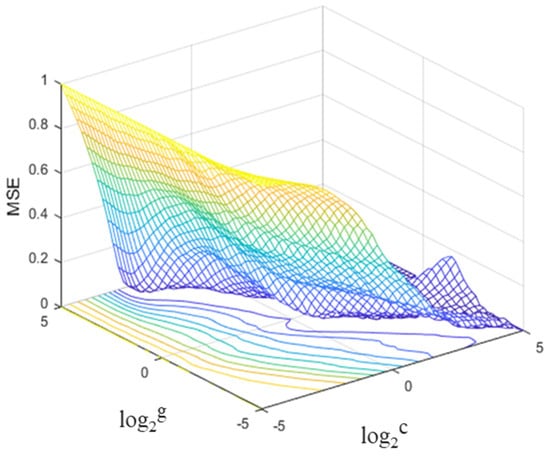
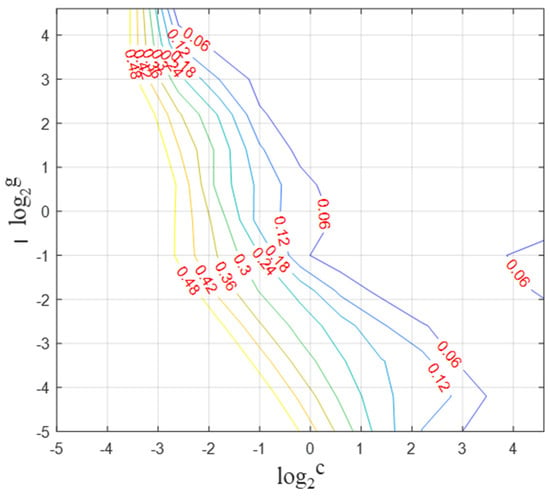
Figure 6.
Solving hyperparameters using GS method.
After obtaining the optimal combination of hyperparameters, the framework of the GS-SVR model for estimating the peak dilation angle is shown in Figure 7. In machine learning, a training set is typically used to build the model and verify the model’s ability to predict new data on an independent test set [81]. Therefore, the original dataset is randomly divided into two subsets after the dataset normalization: the training set and the test set. Through optimization analysis, 80% of the entire dataset was included in the training set and the remaining 20% was included in the test set.
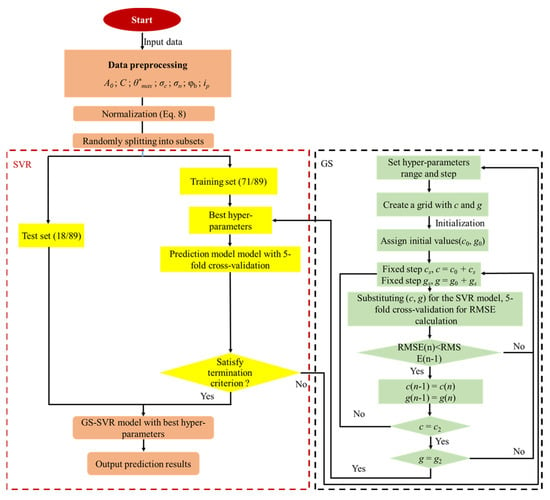
Figure 7.
Prediction process of the proposed ML-based model.
4.2. Performance of GS-SVR Model
The coefficient of determination (R2), adjusted R2 (Adj. R2), root mean square error (RMSE), and mean absolute percentage error (MAPE) have been widely used for the performance evaluation of ML. These four evaluation indices are used to characterize the relationship between the predicted and test values of the peak dilation angle. R2 is a comprehensive metric to measure how strong the relationship is between the two variables. Adj. R2 represents the ability to accurately predict samples. The RMSE is a metric for how much actual values vary from the average of the estimated values. The MAPE measures the average relative error between the estimated and actual values. Generally, R2 (Adj. R2) values equal to 1 and RMSE (MAPE) values equal to 0 indicate the best prediction performance. The mathematical expressions for these four evaluation indices are listed below [82]:
where yim is the measured results; yip is the predicted results; is the average of yim; N represents the number of samples; m represents the number of input variables.
In order to highlight the predictive performance of the proposed model, the original SVR model is also applied to the training set and test set. Figure 8 shows the prediction effect of the two models on the same training set and test set. The calculation of evaluation indices of the two models is shown in Table 3. It can be found that, compared with the SVR model, the GS-SVR model has a higher correlation coefficient (R2 and Adj. R2) and smaller error index (MAPE and RMSE). Figure 8b indicates that the GS-SVR model underestimates most of the test set and this is conducive to leaving some safety redundancy in engineering. Regardless of the training set or the test set, the predicted results of the GS-SVR model are distributed near the ideal fit line, and the predicted values are closer to the experimental results than the original SVR model. The values of evaluation indices shown in bold rows in Table 3 also indicate that the predicted values of the GS-SVR model are more consistent with the experimental values, and the predicted results are more accurate than those of the original SVR model.
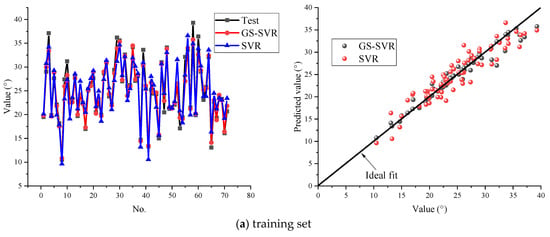
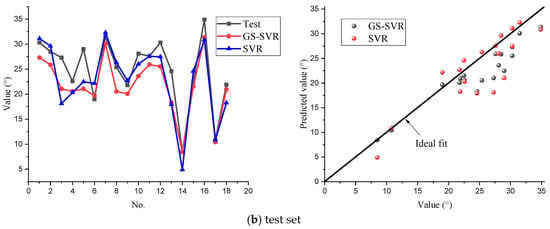
Figure 8.
Performance of the model on the (a) training set; (b) test set.

Table 3.
Performance comparison of the proposed GS-SVR and SVR models.
4.3. Comparison with Existing Models
In order to verify the superiority of the new model, the proposed model is compared with six existing analytical models. The proposed model, Ban et al. (2023) model [22], Ban (2020) model [40], Grasselli (2001) model [79], Xia (2014) model [38], Yang (2016) model [39], and Tatone (2010) model [80] were, respectively, applied to this database, and the predictions of each model are shown in Table 4.

Table 4.
Comparison between the measured peak dilation angle and the calculated values by different models.
In order to make the estimation results more vivid, the estimation results and errors of each model are drawn, as shown in Figure 9. It can be seen from Figure 9 that the estimation performance of the GS-SVR model is significantly better than the other six models. The four evaluation indices shown in Figure 9 also indicate that the GS-SVR model outperformed the other six models in terms of predicting the peak dilation angle. That is, the lowest MAPE = 4.5% (RMSE = 1.663) and the highest R2 = 0.917 (Adj. R2 = 0.916) values for the dataset were obtained from the GS-SVR model. From this point of view, the GS-SVR model is easier and more robust than existing models. Interestingly, the evaluation indices for both training set (R2 = 0.92, RMSE = 1.138) and test set (R2 = 0.891, RMSE = 1.798) were similar to that obtained using the dataset (R2 = 0.917, RMSE = 1.663), which also suggests the GS-SVR model has similar accuracy in both fitting and prediction and has high generalizability.
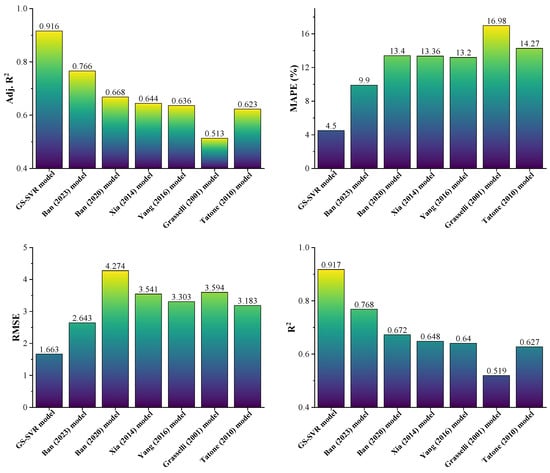
Figure 9.
Performance comparison between the GS-SVR model and other models.
5. Discussion
5.1. Relative Importance of Inputs
A sensitivity analysis of diverse input variables is carried out for a better understanding of the peak dilation angle. The method used for interpreting the relative importance of input variables is Kendall’s tau coefficient. Figure 10 demonstrates the obtained relative importance scores for each input variable. Note that each input variable contributes to the peak dilation angle, but with different levels of significance. It can be seen that the σn is the most sensitive variable for peak dilation angle. The influence of the A0 on the peak dilation angle is found to be the smallest among the input variables. The relative importance score of each input variable revealed important discoveries and indicated potential experimental studies of peak dilation angle. These findings might provide a more detailed understanding of the peak dilation angle and present potential experimental studies in the future.
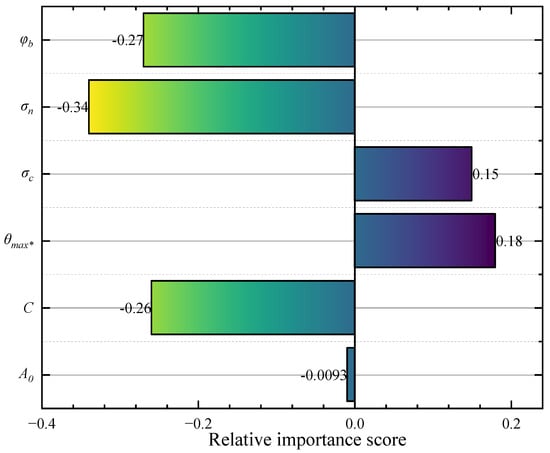
Figure 10.
Relative importance score of input variables.
5.2. Contribution and Limitations
The primary advantage of this study is that a machine-learning-based model for predicting peak dilation angle is proposed. This method can provide a low-cost, time-saving, and non-destructive prediction of peak dilation angle for relevant geotechnical engineering, especially for projects with time and budget constraints.
Compared with the existing prediction models, the method has the following advantages: (1) the GS-SVR model does not require any mechanical testing after model training is completed; (2) the generalization capability of the GS-SVR model can be easily improved using large datasets, which may be better than the empirical equations established between the peak dilation angle and each influencing variable; (3) compared with the six analytical models to predict peak dilation angle, the advantages of ML techniques are strong data compatibility and model generalization. The accuracy of the GS-SVR model is the highest relative to the six analytical models.
There are still some shortcomings that need to be explored in the future. The scale effect is an important research topic in rock mechanics, and the effect of scale on shear mechanical behaviour of rock discontinuities is still unknown. In rock engineering design, the accurate understanding and mastering of the law of rock scale effect is related to the selection of rock mechanics parameters. How to extend the proposed model based on laboratory test results to the engineering scale is the next important research topic, and how to apply this model to industrialization is also an interesting direction. It might be necessary to create a graphics user interface (GUI). The omission of factors such as water content, shear displacement rate, and temperature is also a clear limitation of this study. In addition, as a data-driven approach, the predictive performance of the proposed model is severely affected by the quantity and quality of the Supporting Dataset. The method might be limited in some cases if there are information restrictions or not enough rock samples available. The final limitation is that the generalization capability of the proposed model on completely unknown test results (e.g., not included in this dataset) has not been fully investigated.
6. Conclusions
This paper intends to provide an efficient method for predicting the peak dilation angle of rock discontinuities using a machine learning tool. The method is a hybrid GS-SVR model, which incorporates support vector regression (SVR) techniques and augments with the grid search optimization algorithm to improve prediction performance and optimize hyperparameters. To train and evaluate the proposed model, relevant datasets from experimental tests on various rocks were retrieved and GS and K-fold cross-validation methods were adapted to eliminate the overfitting or underfitting problem of the SVR model. From the analysis results, it is found that the hybrid GS-SVR model has higher prediction accuracy and less error compared with the original SVR model and existing analytical models. In addition, a sensitivity analysis was performed to examine the relative importance score of the three input variables (three-dimensional roughness, normal stress, and basic friction angle). The normal stress has the greatest effect on the peak dilation angle, followed by the basic friction angle and the least three-dimensional roughness.
Supplementary Materials
The following supporting information can be downloaded at: https://www.mdpi.com/article/10.3390/ma16196382/s1.
Author Contributions
Conceptualization, S.X.; data curation, S.X.; visualization, R.Y.; funding acquisition, H.L. and S.X.; investigation, Y.C. and P.Z.; methodology, S.X. and R.Y.; writing—original draft, Y.Y.; writing—review and editing, Y.Y. and H.L. All authors have read and agreed to the published version of the manuscript.
Funding
This paper received financial funding from Postgraduate Research and Practice Innovation Program of Jiangsu Province (No. KYCX23_0276), the National Natural Science Foundation of China (No. 42277175), Hunan Provincial Natural Science Foundation of China (No. 2023JJ30657), and Hunan provincial key research and development Program (No. 2022SK2082).
Data Availability Statement
Data available on request due to privacy restrictions.
Conflicts of Interest
The authors declare no conflict of interest.
Abbreviations
| τp | Shear strength |
| ip | Peak dilation angle |
| i0 | Dilation angle under zero normal stress (°) |
| φb | Basic friction angle |
| k1k2 | Fitting constant |
| SRP | Stationary roughness profile |
| p, q | Regression coefficients |
| C | Roughness parameter characterizing distribution of apparent dip angles over joint surface |
| θA | Average angle of asperities facing shear direction |
| JRC | Joint roughness coefficient |
| JCS | Joint wall compressive strength |
| σn | Normal stress |
| σc | Uniaxial compressive strength |
| a, c, d | Fitting constants |
| σt | Tension strength |
| A0 | Maximum potential contact area for the specified shear direction |
| θmax | Maximum apparent dip angle (°) |
| Average of the mean profile angles | |
| Fitting constant |
References
- Liu, J.; Zhao, Y.; Tan, T.; Zhang, L.; Zhu, S.; Xu, F. Evolution and modeling of mine water inflow and hazard characteristics in southern coalfields of China: A case of Meitanba mine. Int. J. Min. Sci. Technol. 2022, 32, 513–524. [Google Scholar] [CrossRef]
- Yu, W.J.; Li, K.; Liu, Z.; An, B.F.; Wang, P.; Wu, H. Mechanical characteristics and deformation control of surrounding rock in weakly cemented siltstone. Environ. Earth Sci. 2021, 80, 337. [Google Scholar] [CrossRef]
- Hu, K.; Zheng, J.; Wu, H.; Jia, Q. Temperature distribution and equipment layout in a deep chamber: A case study of a coal mine substation. Sustainability 2022, 14, 3852. [Google Scholar] [CrossRef]
- Yuan, W.; Cheng, Y.; Min, M.; Wang, X. Study on acoustic emission characteristics during shear deformation of rock structural planes based on particle flow code. Comput. Part. Mech. 2023. [Google Scholar] [CrossRef]
- Lin, H.; Feng, J.J.; Cao, R.H.; Xie, S.J. Comparative analysis of rock damage models based on different distribution functions. Geotech. Geol. Eng. 2022, 40, 301–310. [Google Scholar] [CrossRef]
- Chen, W.; Wan, W.; Zhao, Y.; Peng, W. Experimental study of the crack predominance of rock-like material containing parallel double fissures under uniaxial compression. Sustainability 2020, 12, 5188. [Google Scholar] [CrossRef]
- Niktabar, S.M.M.; Rao, K.S.; Shrivastava, A.K.; Scucka, J. Effect of varying normal stiffness on soft rock joints under cyclic shear loads. Materials 2023, 16, 4272. [Google Scholar] [CrossRef] [PubMed]
- Xie, S.J.; Lin, H.; Chen, Y.F.; Wang, Y.X.; Cao, R.H.; Li, J.T. Statistical damage shear constitutive model of rock joints under seepage pressure. Front. Earth Sci. 2020, 8, 16. [Google Scholar] [CrossRef]
- Li, M.; Lv, H.; Lu, Y.; Wang, D.; Shi, S.; Li, R. Instantaneous discharge characteristics and its methane ignition mechanism of coal mine rock damage. Environ. Sci. Pollut. Res. 2022, 29, 62495–62506. [Google Scholar] [CrossRef]
- Cai, W.; Zhu, H.; Liang, W. Three-dimensional tunnel face extrusion and reinforcement effects of underground excavations in deep rock masses. Int. J. Rock Mech. Min. Sci. 2022, 150, 104999. [Google Scholar] [CrossRef]
- Cai, W.; Zhu, H.; Liang, W. Three-dimensional stress rotation and control mechanism of deep tunneling incorporating generalized Zhang–Zhu strength-based forward analysis. Eng. Geol. 2022, 308, 106806. [Google Scholar] [CrossRef]
- Xie, S.; Lin, H.; Duan, H. A novel criterion for yield shear displacement of rock discontinuities based on renormalization group theory. Eng. Geol. 2023, 314, 107008. [Google Scholar] [CrossRef]
- Develi, K. Computation of direction dependent joint surface parameters through the algorithm of triangular prism surface area method: A theoretical and experimental study. Int. J. Solids Struct. 2020, 202, 895–911. [Google Scholar] [CrossRef]
- Pellet, F.L.; Keshavarz, M.; Boulon, M. Influence of humidity conditions on shear strength of clay rock discontinuities. Eng. Geol. 2013, 157, 33–38. [Google Scholar] [CrossRef]
- Zhao, Y.L.; Liu, Q.; Zhang, C.S.; Liao, J.; Lin, H.; Wang, Y.X. Coupled seepage-damage effect in fractured rock masses: Model development and a case study. Int. J. Rock Mech. Min. Sci. 2021, 144, 104822. [Google Scholar] [CrossRef]
- Xin, J.; Jiang, Q.; Li, S.; Chen, P.; Zhao, H. Fracturing and energy evolution of rock around prefabricated rectangular and circular tunnels under shearing load: A comparative analysis. Rock Mech. Rock Eng. 2023. [Google Scholar] [CrossRef]
- Shaunik, D.; Singh, M. Bearing capacity of foundations on rock slopes intersected by non-persistent discontinuity. Int. J. Min. Sci. Technol. 2020, 30, 669–674. [Google Scholar] [CrossRef]
- Bahaaddini, M.; Hagan, P.C.; Mitra, R.; Khosravi, M.H. Experimental and numerical study of asperity degradation in the direct shear test. Eng. Geol. 2016, 204, 41–52. [Google Scholar] [CrossRef]
- Wu, H.; Jia, Q.; Wang, W.; Zhang, N.; Zhao, Y. Experimental test on nonuniform deformation in the tilted strata of a deep coal mine. Sustainability 2021, 13, 13280. [Google Scholar] [CrossRef]
- Peng, Y.; Liu, G.; Wu, L.; Zuo, Q.; Liu, Y.; Zhang, C. Comparative study on tunnel blast-induced vibration for the underground cavern group. Environ. Earth Sci. 2021, 80, 68. [Google Scholar] [CrossRef]
- Yan, Y.-T.; Wang, S.-W. Simulation investigation of mechanical and failure characteristics of jointed rock with different shapes of joint asperities under compression loading. Comput. Part. Mech. 2023, 10, 45–59. [Google Scholar] [CrossRef]
- Liren, B.; Yuhang, H.; Weisheng, D.; Jin, Y.; Chengzhi, Q.; Renliang, S. A new peak dilation angle model for rock joints considering different contribution proportions of actual contact joint asperities to shear strength. J. China Coal Soc. 2023, 1–12. [Google Scholar] [CrossRef]
- Xie, S.; Lin, H.; Chen, Y. New constitutive model based on disturbed state concept for shear deformation of rock joints. Arch. Civ. Mech. Eng. 2022, 23, 26. [Google Scholar] [CrossRef]
- Khayrutdinov, M.M.; Kongar-Syuryun, C.B.; Khayrutdinov, A.M.; Tyulyaeva, Y.S. Improving safety when extracting water-soluble ores by optimizing the parameters of the backfill mass. Occup. Saf. Ind. 2021, 53–59. [Google Scholar] [CrossRef]
- Rybak, J.; Tyulyaeva, Y.; Kongar-Syuryun, C.; Khayrutdinov, A.M.; Akinshin, I. Geomechanical substantiation of parameters of technology for mining salt deposits with a backfill. Min. Sci. 2021, 28, 19–32. [Google Scholar] [CrossRef]
- Tang, Z.; Xia, C.; Song, Y. New peak shear strength criteria for roughness joints. Chin. J. Geotech. Eng. 2013, 35, 571–577. [Google Scholar]
- Yuan, W.; Min, M. Investigation on the scale dependence of shear mechanical behavior of rock joints using DEM simulation. Comput. Part. Mech. 2023. [Google Scholar] [CrossRef]
- Nguyen, V.-M.; Konietzky, H.; Frühwirt, T. New methodology to characterize shear behavior of joints by combination of direct shear box testing and numerical simulations. Geotech. Geol. Eng. 2014, 32, 829–846. [Google Scholar] [CrossRef]
- Cai, W.; Zhu, H.; Liang, W.; Wang, X.; Su, C.; Wei, X. A post-peak dilatancy model for soft rock and its application in deep tunnel excavation. J. Rock Mech. Geotech. 2023, 15, 683–701. [Google Scholar] [CrossRef]
- Zhao, Y.L.; Zhang, C.S.; Wang, Y.X.; Lin, H. Shear-related roughness classification and strength model of natural rock joint based on fuzzy comprehensive evaluation. Int. J. Rock Mech. Min. Sci. 2021, 137, 104550. [Google Scholar] [CrossRef]
- Yuan, Z.; Zhao, J.; Li, S.; Jiang, Z.; Huang, F. A unified solution for surrounding rock of roadway considering seepage, dilatancy, strain-softening and intermediate principal stress. Sustainability 2022, 14, 8099. [Google Scholar] [CrossRef]
- Wang, F.; Xie, H.; Zhou, C.; Wang, Z.; Li, C. Combined effects of fault geometry and roadway cross-section shape on the collapse behaviors of twin roadways: An experimental investigation. Tunn. Undergr. Space Technol. 2023, 137, 105106. [Google Scholar] [CrossRef]
- Cai, W.; Su, C.; Zhu, H.; Liang, W.; Ma, Y.; Xu, J.; Xu, C. Elastic–plastic response of a deep tunnel excavated in 3D Hoek–Brown rock mass considering different approaches for obtaining the out-of-plane stress. Int. J. Rock Mech. Min. Sci. 2023, 169, 105425. [Google Scholar] [CrossRef]
- Xie, S.; Lin, H.; Cheng, C.; Chen, Y.; Wang, Y.; Zhao, Y.; Yong, W. Shear strength model of joints based on Gaussian smoothing method and macro-micro roughness. Comput. Geotech. 2022, 143, 104605. [Google Scholar] [CrossRef]
- Ding, L.; Li, G. Research on peak shear strength criterion of rock joints based on the evolution of dilation angle. Geotech. Geol. Eng. 2021, 39, 4887–4900. [Google Scholar] [CrossRef]
- Ladanyi, B.; Archambault, G. (Eds). In Simulation of shear behavior of a jointed rock mass. In Proceedings of the 11th US Symposium on Rock Mechanics (USRMS), Berkeley, CA, USA, 16 June 1969; OnePetro: Richardson, TX, USA, 1969. [Google Scholar]
- Schneider, H. The friction and deformation behaviour of rock joints. Rock Mech. 1976, 8, 169–184. [Google Scholar] [CrossRef]
- Xia, C.-C.; Tang, Z.-C.; Xiao, W.-M.; Song, Y.-L. New peak shear strength criterion of rock joints based on quantified surface description. Rock Mech. Rock Eng. 2014, 47, 387–400. [Google Scholar] [CrossRef]
- Yang, J.; Rong, G.; Hou, D.; Peng, J.; Zhou, C. Experimental study on peak shear strength criterion for rock joints. Rock Mech. Rock Eng. 2016, 49, 821–835. [Google Scholar] [CrossRef]
- Ban, L.; Du, W.; Qi, C. A peak dilation angle model considering the real contact area for rock joints. Rock Mech. Rock Eng. 2020, 53, 4909–4923. [Google Scholar] [CrossRef]
- Barton, N. Review of a new shear-strength criterion for rock joints. Eng. Geol. 1973, 7, 287–332. [Google Scholar] [CrossRef]
- Jing, L.; Nordlund, E.; Stephansson, O. An experimental study on the anisotropy and stress-dependency of the strength and deformability of rock joints. Int. J. Rock Mech. Min. Sci. 1992, 29, 535–542. [Google Scholar] [CrossRef]
- Kulatilake, P.; Shou, G.; Huang, T.; Morgan, R. New peak shear strength criteria for anisotropic rock joints. Int. J. Rock Mech. Min. Sci. 1995, 32, 673–697. [Google Scholar] [CrossRef]
- Ghazvinian, A.H.; Taghichian, A.; Hashemi, M.; Mar’ashi, S.A. The shear behavior of bedding planes of weakness between two different rock types with high strength difference. Rock Mech. Rock Eng. 2010, 43, 69–87. [Google Scholar] [CrossRef]
- Ghazvinian, A.H.; Azinfar, M.J.; Geranmayeh Vaneghi, R. Importance of tensile strength on the shear behavior of discontinuities. Rock Mech. Rock Eng. 2012, 45, 349–359. [Google Scholar] [CrossRef]
- Tang, Z.-C.; Liu, Q.-S.; Huang, J.-H. New criterion for rock joints based on three-dimensional roughness parameters. J. Cent. South Univ. 2014, 21, 4653–4659. [Google Scholar] [CrossRef]
- Kumar, R.; Verma, A.K. Anisotropic shear behavior of rock joint replicas. Int. J. Rock Mech. Min. Sci. 2016, 90, 62–73. [Google Scholar] [CrossRef]
- Cao, P.; Long, L.; Fan, W.; Fan, X.; Cao, R. Peak shear strength criterion for rock joints based on undulating characteristics. J. Cent. South Univ. 2017, 48, 1081–1087. [Google Scholar]
- Zhao, Y.L.; Tang, J.Z.; Chen, Y.; Zhang, L.Y.; Wang, W.J.; Wan, W.; Liao, J.P. Hydromechanical coupling tests for mechanical and permeability characteristics of fractured limestone in complete stress-strain process. Environ. Earth Sci. 2017, 76, 24. [Google Scholar] [CrossRef]
- Zhao, Y.L.; Luo, S.L.; Wang, Y.X.; Wang, W.J.; Zhang, L.Y.; Wan, W. Numerical analysis of karst water inrush and a criterion for establishing the width of water-resistant rock pillars. Mine Water Environ. 2017, 36, 508–519. [Google Scholar] [CrossRef]
- Peng, K.; Yi, G.; Wang, Y.; Luo, S.; Wu, H. Experimental and theoretical analysis of spalling in deep hard rock tunnels with different arch structures. Theor. Appl. Fract. Mech. 2023, 127, 104054. [Google Scholar] [CrossRef]
- Luo, S.; Gong, F.; Peng, K.; Liu, Z. Influence of water on rockburst proneness of sandstone: Insights from relative and absolute energy storage. Eng. Geol. 2023, 323, 107172. [Google Scholar] [CrossRef]
- Xie, S.J.; Lin, H.; Wang, Y.X.; Chen, Y.F.; Xiong, W.; Zhao, Y.L.; Du, S.G. A statistical damage constitutive model considering whole joint shear deformation. Int. J. Damage Mech. 2020, 29, 988–1008. [Google Scholar] [CrossRef]
- Xie, S.J.; Lin, H.; Chen, Y.F.; Wang, Y.X. A new nonlinear empirical strength criterion for rocks under conventional triaxial compression. J. Cent. South Univ. 2021, 28, 1448–1458. [Google Scholar] [CrossRef]
- Xie, S.; Lin, H.; Chen, Y.; Duan, H.; Liu, H.; Liu, B. Prediction of shear strength of rock fractures using support vector regression and grid search optimization. Mater. Today Commun. 2023, 36, 106780. [Google Scholar] [CrossRef]
- Jaskowiec, K.; Wilk-Kolodziejczyk, D.; Bartlomiej, S.; Reczek, W.; Bitka, A.; Malysza, M.; Doroszewski, M.; Pirowski, Z.; Boron, L. Assessment of the quality and mechanical parameters of castings using machine learning methods. Materials 2022, 15, 2884. [Google Scholar] [CrossRef] [PubMed]
- Sun, Z.; Li, Y.; Li, Y.; Su, L.; He, W. Prediction of chloride ion concentration distribution in basalt-polypropylene fiber reinforced concrete based on optimized machine learning algorithm. Mater. Today Commun. 2023, 36, 106565. [Google Scholar] [CrossRef]
- Sun, Z.; Niu, D.; Luo, D.; Wang, X.; Zhang, L.; Su, L.; Li, Y. Hybrid machine learning-based prediction model for the bond strength of corroded Cr alloy-reinforced coral aggregate concrete. Mater. Today Commun. 2023, 35, 106141. [Google Scholar] [CrossRef]
- Wu, Y.; Wang, Y.; Li, D.; Zhang, J. Two-step detection of concrete internal condition using array ultrasound and deep learning. NDT E Int. 2023, 139, 102945. [Google Scholar] [CrossRef]
- Zhang, H.; Su, Y.; Li, A.; Guo, P. Experimental investigation of novel pre-compressed viscoelastic dampers with different matrix materials. Structures 2023, 53, 625–641. [Google Scholar] [CrossRef]
- Xu, G.; Guo, T.; Li, A.Q.; Zhang, H.Y. Self-centering beam-column joints with variable stiffness for steel moment resisting frame. Eng. Struct. 2023, 278, 115526. [Google Scholar] [CrossRef]
- Garcia-Gonzalo, E.; Fernandez-Muniz, Z.; Nieto, P.J.G.; Sanchez, A.B.; Fernandez, M.M. Hard-rock stability analysis for span design in entry-type excavations with learning classifiers. Materials 2016, 9, 531. [Google Scholar] [CrossRef]
- Fakhri, D.; Mahmoodzadeh, A.; Hussein Mohammed, A.; Khodayari, A.; Hashim Ibrahim, H.; Rashidi, S.; Taher Karim, S.H. Forecasting failure load of Sandstone under different Freezing-Thawing cycles using Gaussian process regression method and grey wolf optimization algorithm. Theor. Appl. Fract. Mec. 2023, 125, 103876. [Google Scholar] [CrossRef]
- Chen, J.; Huang, H.; Cohn, A.G.; Zhang, D.; Zhou, M. Machine learning-based classification of rock discontinuity trace: SMOTE oversampling integrated with GBT ensemble learning. Int. J. Min. Sci. Technol. 2022, 32, 309–322. [Google Scholar] [CrossRef]
- Sun, Z.; Wang, L.; Zhou, J.-Q.; Wang, C. A new method for determining the hydraulic aperture of rough rock fractures using the support vector regression. Eng. Geol. 2020, 271, 105618. [Google Scholar] [CrossRef]
- Huang, J.; Zhang, J.; Gao, Y. Intelligently predict the rock joint shear strength using the support vector regression and firefly algorithm. Lithosphere 2021, 2021, 2467126. [Google Scholar] [CrossRef]
- Babanouri, N.; Fattahi, H. Constitutive modeling of rock fractures by improved support vector regression. Environ. Earth Sci. 2018, 77, 243. [Google Scholar] [CrossRef]
- Ceryan, N.; Ozkat, E.C.; Can, N.K.; Ceryan, S. Machine learning models to estimate the elastic modulus of weathered magmatic rocks. Environ. Earth Sci. 2021, 80, 448. [Google Scholar] [CrossRef]
- Xu, C.; Nait Amar, M.; Ghriga, M.A.; Ouaer, H.; Zhang, X.; Hasanipanah, M. Evolving support vector regression using Grey Wolf optimization; forecasting the geomechanical properties of rock. Eng. Comput. 2022, 38, 1819–1833. [Google Scholar] [CrossRef]
- Safari, M.; Rabiee, A.H.; Joudaki, J. Developing a support vector regression (SVR) model for prediction of main and lateral bending angles in laser tube bending process. Materials 2023, 16, 3251. [Google Scholar] [CrossRef]
- Wu, Y.; Zhou, Y. Splitting tensile strength prediction of sustainable high-performance concrete using machine learning techniques. Environ. Sci. Pollut. Res. 2022, 29, 89198–89209. [Google Scholar] [CrossRef]
- Samui, P. Slope stability analysis: A support vector machine approach. Environ. Geol. 2008, 56, 255–267. [Google Scholar] [CrossRef]
- Wu, Y.Q.; Zhou, Y.S. Hybrid machine learning model and Shapley additive explanations for compressive strength of sustainable concrete. Constr. Build. Mater. 2022, 330, 127298. [Google Scholar] [CrossRef]
- Gilan, S.S.; Jovein, H.B.; Ramezanianpour, A.A. Hybrid support vector regression—Particle swarm optimization for prediction of compressive strength and RCPT of concretes containing metakaolin. Constr. Build. Mater. 2012, 34, 321–329. [Google Scholar] [CrossRef]
- Al-Sodani, K.A.A.; Adewumi, A.A.; Ariffin, M.A.M.; Maslehuddin, M.; Ismail, M.; Salami, H.O.; Owolabi, T.O.; Mohamed, H.D. Experimental and modelling of alkali-activated mortar compressive strength using hybrid support vector regression and genetic algorithm. Materials 2021, 14, 3049. [Google Scholar] [CrossRef]
- Anton, C.; Curteanu, S.; Lisa, C.; Leon, F. Machine learning methods applied for modeling the process of obtaining bricks using silicon-based materials. Materials 2021, 14, 7232. [Google Scholar] [CrossRef]
- Muhammad; Kennedy, J.; Lim, C.W. Machine learning and deep learning in phononic crystals and metamaterials—A review. Mater. Today Commun. 2022, 33, 104606. [Google Scholar] [CrossRef]
- Chen, J.; Zhou, M.; Huang, H.; Zhang, D.; Peng, Z. Automated extraction and evaluation of fracture trace maps from rock tunnel face images via deep learning. Int. J. Rock Mech. Min. Sci. 2021, 142, 104745. [Google Scholar] [CrossRef]
- Grasselli, G. Shear Strength of Rock Joints Based on Quantified Surface Description; EPFL: Lausanne, Switzerland, 2001. [Google Scholar]
- Tatone, B.S.A.; Grasselli, G. A method to evaluate the three-dimensional roughness of fracture surfaces in brittle geomaterials. Rev. Sci. Instrum. 2009, 80, 125110. [Google Scholar] [CrossRef]
- Lei, Y.; Zhou, S.; Luo, X.; Niu, S.; Jiang, N. A comparative study of six hybrid prediction models for uniaxial compressive strength of rock based on swarm intelligence optimization algorithms. Front. Earth Sci. 2022, 10, 930130. [Google Scholar] [CrossRef]
- Xie, S.; Lin, H.; Duan, H.; Chen, Y. Modeling description of interface shear deformation: A theoretical study on damage statistical distributions. Constr. Build. Mater. 2023, 394, 132052. [Google Scholar] [CrossRef]
Disclaimer/Publisher’s Note: The statements, opinions and data contained in all publications are solely those of the individual author(s) and contributor(s) and not of MDPI and/or the editor(s). MDPI and/or the editor(s) disclaim responsibility for any injury to people or property resulting from any ideas, methods, instructions or products referred to in the content. |
© 2023 by the authors. Licensee MDPI, Basel, Switzerland. This article is an open access article distributed under the terms and conditions of the Creative Commons Attribution (CC BY) license (https://creativecommons.org/licenses/by/4.0/).